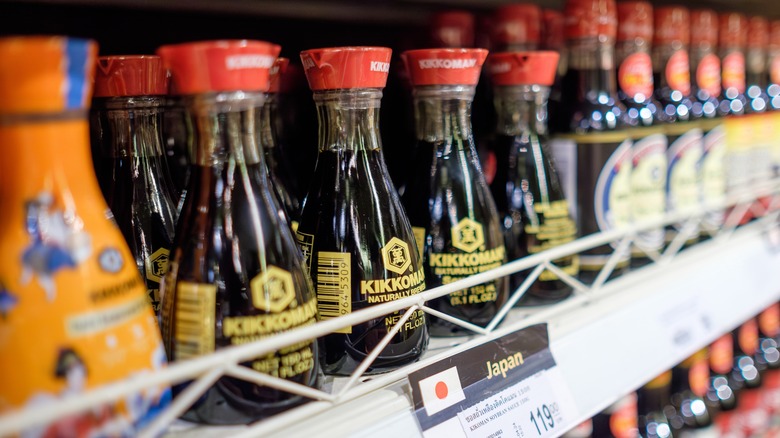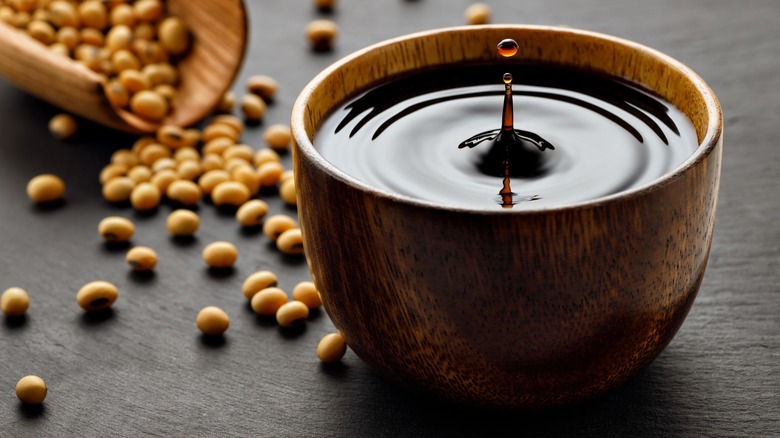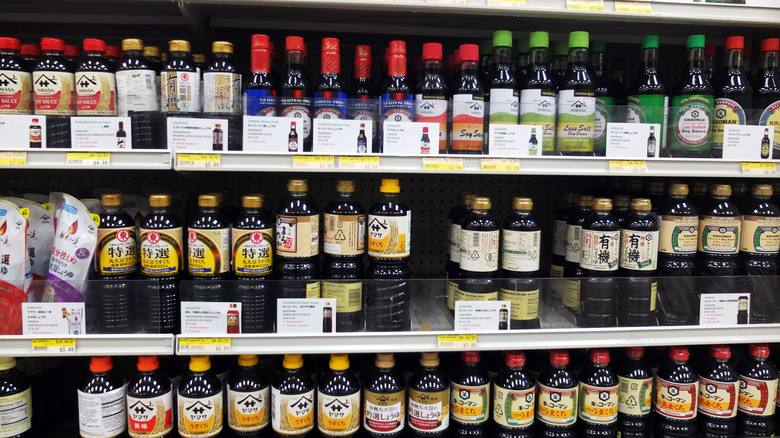It's No Coincidence That Soy Sauce Bottles Have 2 Spouts
One particular soy sauce bottle has become an icon: short and squat, made of glass, so you can easily see how much product remains. And that bright red cap with the two spouts? The two-spout cap is not an accident but actually a well-designed addition to the classic Kikkoman soy sauce bottle that both cuts down on mess and helps control sauce flow. By using this bottle, you wind up with just how much — or how little — soy sauce you want. And you can do it with one finger.
Made from fermented soybeans, water, wheat, and salt, soy sauce is one of the best-known and most widely used Asian condiments, and it has been going strong for over 2,500 years. It is essential for stir-fries, sushi, or as a seasoning for rice or noodles — it even works fabulously as part of a basic marinade during grilling season. It also is a great lower-sodium alternative to table salt, for those who are trying to cut down on their salt intake.
But it can spill onto the table or the parts of your plate that you would rather not sauce. While there are ways to cut down on the mess soy sauce can make, the two-spout bottle offers a simple yet elegant solution to this problem.
How to use the two spout soy sauce bottle
You may have thought that the two-hole spout was designed to allow air in one hole so that sauce could flow smoothly out the other. Or that it lets you pour from two sides — or use one hole if the other becomes clogged. It does all of these, but they were not the primary purpose of the cap's unique design. Rather, the cap was made to be used with a finger (or thumb) to finely and simply control the flow of sauce.
To use the spout, first, grab the bottle with one hand, and then place a finger or thumb over one of the holes. Upend the bottle over the plate of food you wish to sauce ... and nothing happens! The presence of your finger or thumb over one of the holes keeps the sauce from flowing out of the other hole. Remove your finger or thumb from the hole, and the soy sauce flows. When you have added all the sauce you want, cover the hole again to quickly stop the flow.
One of the keys to success here was the inward angle that was designed into the tip of the cap. This prevents the soy sauce from pooling in the cap and dripping where you don't want it to drip.
The origin of the two spout soy sauce bottle
You'll find a wide variety of different soy sauces on the market, but the two-spout bottle by Kikkoman is unique. While the design seems fairly simple in retrospect, getting to the point where it worked perfectly and kept the bottle from dripping took a bit of work.
The bottle and cap combo was created in 1961 by a Japanese (former) Buddhist monk-turned-industrial designer named Kenji Ekuan. Renowned for his innovation, Ekuan believed design could blend elegance with accessibility, evident in the graceful curves of the bottle (and the bullet train) he crafted. Soy sauce, prior to this point, was traditionally sold in close to half-gallon bottles, a size that was difficult to manage without making a serious mess at the table. The memory of his mother pouring soy sauce from these large containers into smaller, more table-friendly versions was part of Ekuan's motivation for creating the classic Kikkoman bottle and cap.
It took Ekuan three years and around 100 tries before he was able to create a spout cap that was lightweight, easy to use, and pleasant to look at. At the time of his death in 2015, over 300 million bottles of the Ekuan-designed bottle had been sold.



